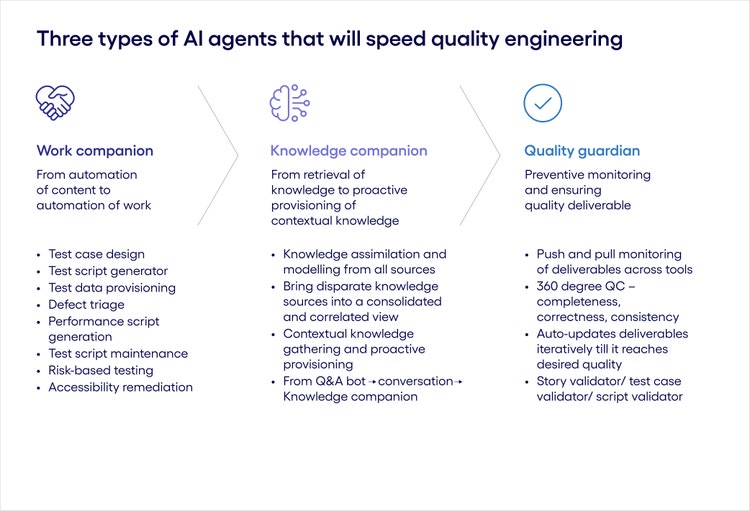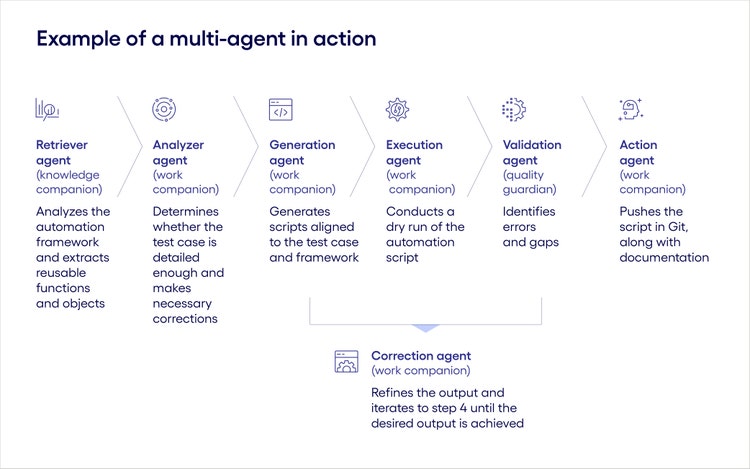<p><br> <span class="small">August 18, 2025</span></p>
Agentic AI: How multi-agent intelligence is redefining quality engineering
<p><b>AI-powered agents are becoming teammates to software engineers to transform quality engineering from the inside out.</b></p>
<p>For businesses today, delivering faster, smarter software is a matter of survival. With elite software teams deploying code multiple times per day, and quality engineering becoming more agile, many are turning to agentic AI to keep up. These AI-powered agents are becoming teammates, working alongside full-stack engineers and software development engineers in test (SDETs) to transform quality engineering from the inside out.</p> <p>Already, AI agents are taking on knowledge-intensive, repetitive tasks in quality engineering, such as test design, validation and execution. By offloading these responsibilities, AI agents can free up software engineers to focus on higher level work, such as defining the sequence of activity, innovation and strategic decision-making.</p> <p>Looking ahead, tomorrow’s quality engineering pods will see AI agents become fully embedded team members, independently performing various tasks. Their role will evolve from being a pair programmer to collaborating with humans on higher-level tasks, delivering a high level of accuracy and auto correction and enabling continuous quality at scale.</p> <p>To take advantage of AI agents in quality engineering, businesses need to become familiar with the type of agents that will emerge, as well as how they will work with software engineers and each other to complete complex tasks. </p> <h4>Types of AI agents and their role in quality engineering</h4> <p>In our work with clients, we see three types of core AI agents emerging, each designed to extend human capability and accelerate quality outcomes. These agents form a modular, intelligent framework that mirrors human logic while operating at machine speed and scale:<br> </p> <ul> <li><b>Work companions</b> are the task performers. They retrieve historical context, generate test plans, write scripts and execute regression tests, handling execution-heavy work with precision and consistency.<br> <br> </li> <li><b>Knowledge companions</b> are the insight engines. They surface relevant documentation, industry benchmarks and past defect patterns to guide decision-making. This empowers engineers with the information they need, when they need it.<br> <br> </li> <li><b>Quality guardians</b> are the always-on auditors. They monitor test environments, flag anomalies and ensure compliance, acting like digital sentinels that safeguard quality across the software development lifecycle.</li> </ul> <p>Together, these agents create a self-improving ecosystem, helping quality engineers reduce time to market with higher automation and accuracy.</p>

#
<p><span class="small">Figure 1</span></p> <h4>Quality engineers and AI agents working in tandem</h4> <p>Agentic AI doesn’t replace engineers; it complements them. Agents, often intended for small tasks, work collaboratively and sometimes even iteratively to achieve the end goal, much like a well-coordinated human team. The level of autonomy between these agents is a function of use case, legal or business requirements.</p> <p>For example, in test case generation, it would be critical for an engineer to be involved in validating which business scenarios to cover. Conversely, in self-healing of automation, AI agents can autonomously determine the next set of actions, validating and rectifying iteratively as needed.</p> <h4>How it all comes together: multi-agentic architecture</h4> <p>While individual agents can perform isolated tasks, multiple agents will typically come together and orchestrate to solve a larger use case. Imagine the following agents collaborating to create a test script:</p>

#
<p><span class="small">Figure 2</span></p> <p>This architecture mirrors how a human tester would approach the task—but with greater speed, consistency and scale.</p> <p>This is just one example of a multi-agent quality engineering workflow. In our work with clients, we’ve identified over 50 MVP-ready use cases, along with proven frameworks that enable agentic AI adoption at scale. In addition to test generation, other use cases gaining traction include self-healing automation, exploratory testing and defect triage.</p> <h4>Preparing for the AI-driven quality engineering shift</h4> <p>The following action items can help organizations get ready for the transformation to agentic AI in quality engineering:<br> </p> <ul> <li><b>Assess your current quality engineering maturity and automation</b> <b>gaps</b>. Using data, analyze the current state of your quality engineering approach and identify potential use cases that would improve its overall maturity.<br> <br> </li> <li><b>Identify pilot use cases for agentic automation</b>. Prepare to adopt agentic AI by selecting the best use case, application and architecture that will deliver the best possible outcome.</li> </ul> <ul> <li><b>Define clear roles for AI agents and humans</b>. Design a solution that includes various AI agents and determines how they will communicate internally, whether agent-to-agent or through a supervisor agent), as well as the role of quality engineers.<br> <br> </li> <li><b>Invest in platforms and skills that support multi-agent collaboration</b>. Select the right tools, ecosystem and skilled resources that will deliver an impactful outcome.</li> </ul> <p>Software—and software quality—has never been more important. With agentic AI, businesses can ensure their software delivery sharpens their competitive edge.<br> </p>
<p>Rutvik is a seasoned technology architect with over 20 years of experience and spearheads solution development and capability building for new technology like gen AI, continuous testing, cloud, IOT and AR/VR. His efforts are instrumental in establishing gen AI capabilities within QE&A, having developed and implemented over 50 solutions across 100 customers.</p>


